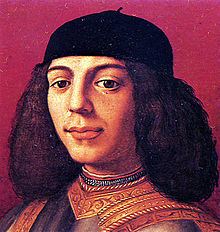Piero di Lorenzo de 'Medici


Piero di Lorenzo de 'Medici (called il Fatuo or lo Sfortunato ("the unfortunate"); * February 15, 1472 in Florence ; † December 28 or 29, 1503 at Gaeta ) was the eldest son of Lorenzo the Magnificent and ruled as his Successor from 1492 to 1494 Florence. His nickname refers to his political failure, which paved the way for the rule of the Dominican Girolamo Savonarola .
Life
Although Lorenzo the Magnificent de jure was not a prince, but only a simple citizen of the city of Florence, the Council of Seventy , the most important governmental body of the city created by its followers, recognized the de facto rule of the Medici and, after Lorenzo's death, paved the way for his son Piero Way to power. He was appointed Accoppiatore in violation of the regular minimum age and thus received a key role in filling state offices.
Piero de 'Medici was interested in many things. He dealt with poetry, collected valuable manuscripts and successfully took care of the recovery of the ailing Medici Bank . Political expertise, on the other hand, was not one of his strengths. Between 1492 and 1494, when Charles VIII of France initiated a war against Naples , he was trapped in his dynastic relationship with the Orsini . Through them he was bound to Naples while he stood against the French and against the beleaguered Milanese regent Ludovico Sforza , who called them into the country.
Piero now wanted to limit the damage and he handed over the most important Florentine fortresses and the ports of Pisa and Livorno to Charles in order to save his own rule. These measures were disapproved of by the greats of the city. Piero's appearance in front of the Signoria , accompanied by several armed men , at which he wanted to justify his unsuccessful rescue operation, finally brought the barrel to overflowing.
An angry crowd plundered the Medici Palace, Piero's brothers Giovanni (later Pope Leo X ) and Giuliano and his cousin Giulio (later Clement VII ) fled to Bologna . Piero himself also had to leave the city on November 9, 1494 and went to Venice for the time being . The Medici were in exile for almost eighteen years. Piero's mistake in attempts to return was always that he allied himself with foreign enemies of the republic, such as Cesare Borgia , so that he promoted the unity of the Florentines and made himself even more hated. In addition, the French King Louis XII tolerated . no repatriation because he wanted to integrate Florence safely into his clientele in the battle for Italy between north and south. The Florentines were dependent on Ludwig's favor.
Were the Medici bounties exposed to 4000 Florin on Piero and 2000 to his brother Giovanni. Her art treasures kept in the Palazzo Medici , including many valuable manuscripts, were partly destroyed and partly stolen, only a fraction of which was saved to Rome at the end of 1495.
The unhappy Piero did not live to see his family return to power. He fought in southern Italy for France against the Spaniards. After the French troops suffered a defeat in the Battle of Garigliano in December 1503, Piero wanted to flee to the south side of the Garigliano River and also bring some valuable artillery to safety. He loaded the barge on which he and his men were going to cross the river with four cannons. The boat overturned due to the excess weight and heavy headwind, whereupon Piero drowned. His body was found a few days later near Gaeta in the mouth of the Garigliano. He was buried in the abbey church of Montecassino , where his brother Giovanni was abbot, on the left, behind the altar in the choir. His tomb there was only commissioned by his cousin, Pope Clement VII, after 1530 from Antonio da Sangallo and Francesco da Sangallo and completed in 1539.
Marriage and offspring
Piero married Alfonsina Orsini , the daughter of Roberto Orsini, Count of Tagliacozzo, and Caterina Sanseverinos in 1488 . Two of the couple's children reached adulthood: Lorenzo di Piero de 'Medici (1492–1519), Duke of Urbino and father of Queen Caterina de' Medici of France , and Clarice de 'Medici (1493–1528), wife of Filippo Strozzis the Younger .
literature
- Patrizia Meli: Medici, Piero de '. In: Mario Caravale (ed.): Dizionario Biografico degli Italiani (DBI). Volume 73: Meda-Messadaglia. Istituto della Enciclopedia Italiana, Rome 2009.
- Volker Reinhardt : The Medici. Florence in the age of the Renaissance . 3. Edition. CH Beck, Munich 2004, ISBN 3-406-44028-2 , p. 100-101 .
- Ronald P. Stocker: The Rise and Fall of Piero de Medici. 1492-1494 . Dissertation, Texas Christian University 1975.
- Götz-Rüdiger Tewes: Struggle for Florence - the Medici in exile (1494-1512) . Böhlau, Cologne et al. 2011, ISBN 978-3-412-20643-7 , pp. 13 ff .
- Massimo Winspeare: The Medici. The golden age of great art collections . Sillabe, Livorno 2002, ISBN 88-8347-057-5 , pp. 42-45 .
Web links
- Medici, Piero de '. In: Enciclopedie on line. Istituto della Enciclopedia Italiana, Rome. Retrieved June 18, 2018.
Remarks
- ↑ Götz-Rüdiger Tewes: Battle for Florence - the Medici in Exile (1494–1512) , Cologne 2011, pp. 584–587.
| personal data | |
|---|---|
| SURNAME | Medici, Piero di Lorenzo de ' |
| ALTERNATIVE NAMES | Piero the unfortunate |
| BRIEF DESCRIPTION | Lord of Florence |
| DATE OF BIRTH | February 15, 1472 |
| PLACE OF BIRTH | Florence |
| DATE OF DEATH | December 28, 1503 or December 29, 1503 |
| Place of death | Gaeta |